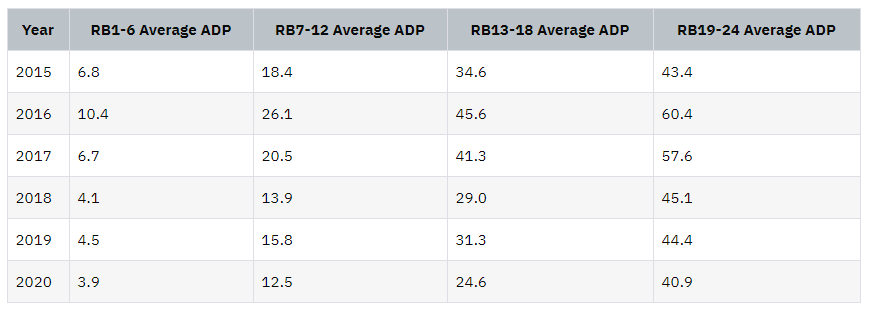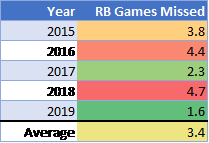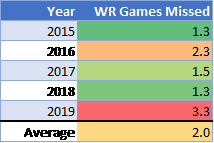Zero RB, popularized by Shawn Siegele at Rotoviz, is a contrarian draft strategy. Do the advanced stats and metrics point to it as a winning strategy in 2020?
RB ADP
From the chart below via Jack Miller at Rotoviz, we can see that running backs are being drafted earlier and earlier every year. This inevitably leaves value at the other positions, making 2020 a strong year to try the strategy. RB ADP Averages: 2015-2020
RB ADP Averages: 2015-2020
Anti-Fragility
The reason running backs are being pushed up the board so much is that last year was a remarkably healthy year for the top-12 backs by ADP. In fact, 2019 was the healthiest the early-round running backs have been over the past five years.
Meanwhile, the top-drafted wide receivers collectively missed more games than they had since 2015.
Wide receivers are also more predictable from season to season. Early in the draft, it is optimal to select predictable players with both a high floor and high ceiling.
Top rbs don’t repeat, top wrs do as a rule
Weirdly missing from the “heavy rb in dynasty” conversation laterly tbh
Almost like everyone always expects what happened last season to happen this season ? pic.twitter.com/Do1M8FcJ6B
— Peter Howard (@pahowdy) July 22, 2020
The data indicates that wide receivers, not running backs, fit that prototype.
Shooting for Upside
This does not mean we are aiming for a high-floor, low-ceiling team: actually the opposite.
I’d rather have Kareem Hunt without Nick Chubb than Nick Chubb with Kareem Hunt
I’d rather have Latavius Murray without Alvin Kamara than Alvin Kamara with Latavius Murray
— Scott Barrett (@ScottBarrettDFB) June 16, 2020
While a Robust RB team may look better after the draft, the best way to shoot for upside is by drafting stud wide receivers early and selecting Zero RB targets late.
Effects of the Coronavirus
The pandemic will insert more randomness into the 2020 NFL season than we’ve become accustomed to. Zero RB is a draft strategy that benefits from randomness and chaos. Any positive test, even a false positive, could cause a player to miss the week’s upcoming game. Even asymptomatic players must wait at least five days and test negative twice before returning.
This benefits backup running backs more than backup wide receivers. The law of the conversation of targets implies that vacated targets from an absent star receiver will be spread out. While coaches may turn to a committee if their starting running back misses time, they may not trust their third or fourth string running backs, and may instead opt to give a full workload to the primary backup.
Check out Alexander Mattison’s 2020 Projection on PlayerProfiler’s “World Famous” Draft Kit:
A simple thought exercise demonstrates this point: if Adam Thielen tests positive and misses a game, we can’t start Olabisi Johnson and automatically expect him to contribute a WR2 performance. However, if Dalvin Cook misses a game, Alexander Mattison is a locked-in RB2 at worst.
When to Use Zero RB
Zero RB can work in Best Ball, but the strategy works even better in redraft where we have access to a waiver wire. Another benefit of implementing Zero RB in redraft is that your team becomes stronger throughout the season, while Robust RB teams deal with the attrition at the position they have invested so heavily in. When the playoffs roll around, we have ideally created something of a super team.
https://www.youtube.com/watch?v=4YCb3nzoFzE
However, even in Best Ball, starting RB-RB has only translated to an 8.8-percent Win Rate per Rotoviz, barely above the 8.3-percent mark we would reach through random chance.
Zero RB works best when we are required to start three wide receivers, ideally in PPR formats, although it can work well in half-PPR as well.
Modified Zero RB
One term that may confuse people is the concept of ‘Modified Zero RB.’ In reality, Modified Zero RB reminds us to be flexible. If you have a top-5 pick, or wherever that cutoff is in your own personal rankings, take one of the elite running backs. We know that running backs win championships, though those running backs are often available late. Don’t force the strategy and take Michael Thomas first overall simply to be on #TeamZeroRB. With Modified Zero RB, we can still continue to hammer wide receivers, and possibly an elite tight end, with our next few picks before throwing our darts at the prime Zero RB targets in the later rounds.
Implementing Zero RB
The absolute worst thing we can do is to start a draft WR-WR and then start chasing running backs in what Sean Koerner of the Action Network has dubbed the Frozen Pond tier.
https://www.youtube.com/watch?v=UFHAVS1kvsc
This year, that tier includes running backs such as Leonard Fournette, Todd Gurley, Le’Veon Bell, and David Johnson – non-elite running backs being pushed up due to nothing more than projected volume.
Summary
It’s important not to take the term “Zero RB” too literally. It is a draft strategy predicated on avoiding non-elite running backs, those who see plenty of empty calorie touches but are not true difference makers at the position. When drafting from the back half of the first round, instead of taking lower-end RB1s in an effort to chase the Christian McCaffrey and Saquon Barkley-led teams, Zero RB allows our team to be strong everywhere else.
If one or two of our late round running back targets break out, we will have a monster team that is primed for a fantasy championship. If you want to finish in fifth place, feel free to start your draft with Nick Chubb and Aaron Jones. Us Zero RB drafters thank you for paying the rake.










